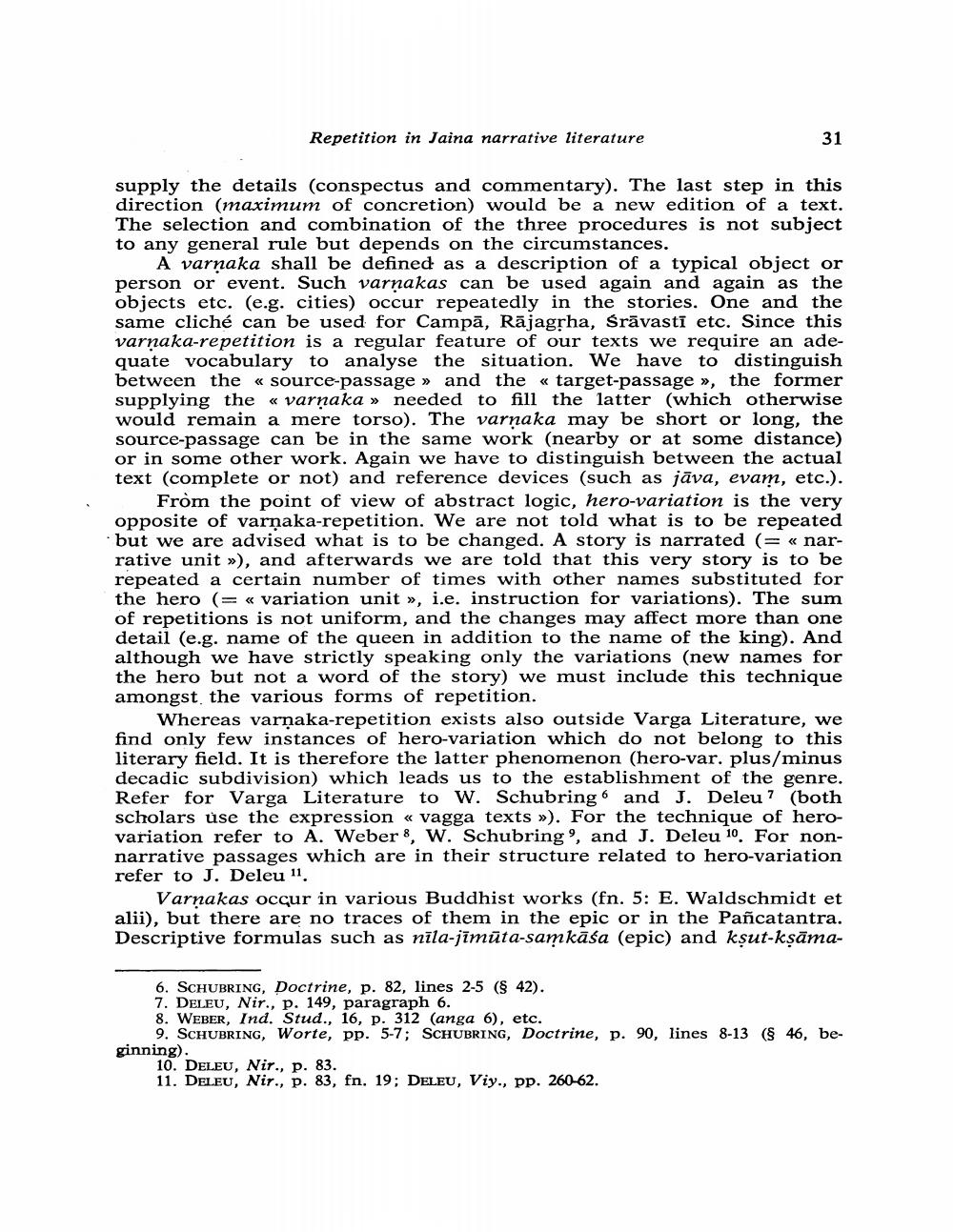Book Title: Repetition In Jaina Nrative Literature Author(s): Klaus Bruhn Publisher: Klaus Bruhn View full book textPage 5
________________ Repetition in Jaina narrative literature 31 supply the details (conspectus and commentary). The last step in this direction (maximum of concretion) would be a new edition of a text. The selection and combination of the three procedures is not subject to any general rule but depends on the circumstances. A varnaka shall be defined as a description of a typical object or person or event. Such varnakas can be used again and again as the objects etc. (e.g. cities) occur repeatedly in the stories. One and the same cliché can be used for Campā, Rājagrha, Srāvastī etc. Since this varnaka-repetition is a regular feature of our texts we require an adequate vocabulary to analyse the situation. We have to distinguish between the «source-passage » and the « target-passage », the former supplying the « varnaka » needed to fill the latter (which otherwise would remain a mere torso). The varņaka may be short or long, the source-passage can be in the same work (nearby or at some distance) or in some other work. Again we have to distinguish between the actual text (complete or not) and reference devices (such as jāva, evam, etc.). From the point of view of abstract logic, hero-variation is the very opposite of varņaka-repetition. We are not told what is to be repeated but we are advised what is to be changed. A story is narrated (= « narrative unit »), and afterwards we are told that this very story is to be repeated a certain number of times with other names substituted for the hero (= « variation unit », i.e. instruction for variations). The sum of repetitions is not uniform, and the changes may affect more than one detail (e.g. name of the queen in addition to the name of the king). And although we have strictly speaking only the variations (new names for the hero but not a word of the story) we must include this technique amongst the various forms of repetition. Whereas varņaka-repetition exists also outside Varga Literature, we find only few instances of hero-variation which do not belong to this literary field. It is therefore the latter phenomenon (hero-var, plus/minus decadic subdivision) which leads us to the establishment of the genre. Refer for Varga Literature to W. Schubring 6 and J. Deleu? (both scholars use the expression « vagga texts »). For the technique of herovariation refer to A. Weber 8, W. Schubring', and J. Deleu 10. For nonnarrative passages which are in their structure related to hero-variation refer to J. Deleu 11. Varnakas occur in various Buddhist works (fn. 5: E. Waldschmidt et alii), but there are no traces of them in the epic or in the Pañcatantra. Descriptive formulas such as nīla-jīmūta-samkāśa (epic) and kşut-kşāma 6. SCHUBRING, Doctrine, p. 82, lines 2-5 ($ 42). 7. DELEU, Nir., p. 149, paragraph 6. 8. WEBER, Ind. Stud., 16, p. 312 (anga 6), etc. 9. SCHUBRING, Worte, pp. 5-7; SCHUBRING, Doctrine, p. 90, lines 8-13 (8 46, beginning). 10. DELEU, Nir., p. 83. 11. DELEU, Nir., p. 83, fn, 19; DELEU, Viy., pp. 260-62.Page Navigation
1 ... 3 4 5 6 7 8 9 10 11 12 13 14 15 16 17 18 19 20 21 22 23 24 25 26 27 28 29 30 31 32 33 34 35 36 37 38 39 40 41 42 43 44 45 46 47 48 49
